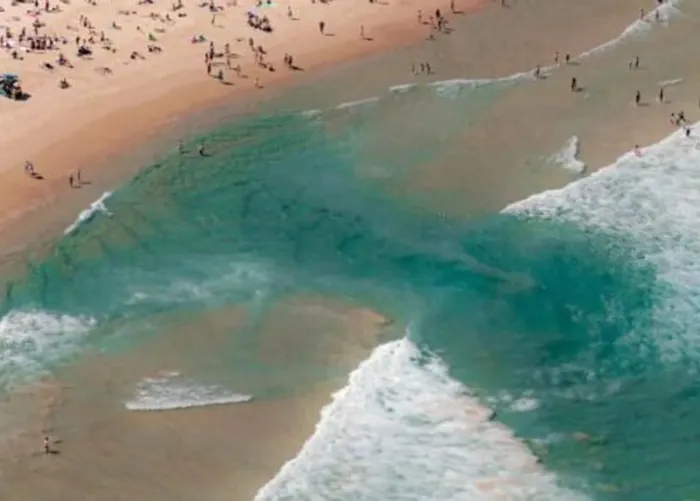The answer to the impact of air pollution lies in … the deep blue sea
ENVIRONMENT

Our oceans are as important to life on Earth as the air we breathe. An enormous carbon sink, they help to remove the greenhouse gas carbon dioxide (CO2) from the atmosphere, which is of course a good thin.
Image: NSRI
By Dr Katye Altieri
Imagine for a moment standing on a sun-soaked beach, the surf crashing against the shore, and inhaling the salty, moist sea air. It’s invigorating.
But is it really? Hundreds of years ago, perhaps, but what about now? How do the ocean and the air interact in the presence of human-created air pollution, specifically nitrogen, and how does this relationship impact climate change?
The simple truth is, we don’t know – and I want to find out.
Our oceans are as important to life on Earth as the air we breathe. An enormous carbon sink, they help to remove the greenhouse gas carbon dioxide (CO2) from the atmosphere, which is of course a good thing.
As a matter of fact, nitrogen helps the oceans to remove CO2 from the atmosphere. The problem is, too much of it can spur the production and release of nitrous oxide (N2O), another greenhouse gas that is 300 times as potent as CO2. That is clearly not a good thing.
As with everything in nature, things work when there’s a balance; invariably, however, we humans throw out that equilibrium through our activities. That’s why we’re struggling so much with the issue of climate change, so much of which has to do with the pollution of our atmosphere.
We have doubled the amount of nitrogen in the atmosphere through activities such as fossil fuel combustion and agriculture. That nitrogen, even from far inland, is swept out to sea and settles in the ocean.
But we don’t know exactly how much pollution-derived nitrogen reaches the open ocean. We don’t know exactly what happens when it settles in the ocean.
And we face a conundrum: does it increase the ocean’s ability to remove greenhouse gases from the atmosphere, or emit more deleterious greenhouse gases into the atmosphere?
The main reason why we don’t know is because climate change science – a large and diverse field of study – is siloed in terms of scientific disciplines and policy frameworks, and the connection between air pollution and the ocean thus isn’t properly assessed. Atmospheric scientists and oceanographers do their own research and even speak their own scientific languages, and governments and their responses mostly don’t consider this aspect.
I intend to help change that, however, by forging new ways of scientific thinking about both our atmosphere and our oceans, helping us to build knowledge in ways we haven’t before. As the recipient of the Oppenheimer Memorial Trust’s 2025 New Frontiers Research Award, my mission is to come up with the evidence that supports (or doesn’t support) various air quality, climate and scientific arguments.
The New Frontiers award affords me the opportunity to lead a world-class research team, including the very best scientists; three exceptional South African women.
Supporting them will be postgraduate students and postdoctoral researchers. Together, we will establish a shared language and methodological approach to the complex interactions between air pollution, nitrogen cycling and oceanic greenhouse gas fluxes.
This is how we will do it:
We will undertake an ambitious observational campaign to measure how much anthropogenic atmospheric nitrogen deposition reaches the coastal and open ocean off the west coast of South Africa. This approach allows for investigation of a nitrogen deposition gradient, and how much of it is created by us
On the question of the impact of atmospheric nitrogen deposition on surface ocean biogeochemistry, we will conduct on-ship incubation experiments using atmospheric deposition collected on land and at sea
To investigate whether atmospheric deposition results in drawdown of CO2 and/or release of N2O from the surface ocean, we will conduct a set of model experiments. First an atmospheric chemistry model will generate fields of nitrogen deposition using current emissions as well as simulated increased anthropogenic emissions, then those deposition fields will be used as inputs to the ocean biogeochemistry model, and the ocean’s response will be quantified
In many ways, South Africa – Cape Town in particular – is the ideal place to do this research. As one of the world’s largest coal-burning countries, the country contributes significantly to atmospheric nitrogen emissions.
Uniquely, we have three diverse ocean systems, allowing for comparative study and measurement, within striking distance:
The upwelling of nutrient-rich, cold waters from the deep ocean in the Benguela current up the west coast of Africa, teeming with phytoplankton that supports abundant marine life
The ocean desert of the South Atlantic Ocean, which is comparatively nutrient-poor and has limited marine life
The time machine that is the Southern Ocean, which boasts as close to the pre-industrial atmosphere as we can get anywhere on Earth – equivalent to the atmosphere up to 200 years ago. (And we have access to the polar research vessel, the R/V S.A. Agulhas II, which allows for research operations in these oceans)
The New Frontiers Research Award offers several benefits: its long-term nature (it is a five-year award) will allow for the building of impactful partnerships; it will promote integrated science, allowing for fieldwork that can be built into models that quantify the big picture for us; and, importantly, it will help scientific observationalists and modellers to connect and network.
Reducing nitrogen emissions may make the oceans’ CO2 sink smaller, yet we cannot justify stopping nitrogen clean-ups. It’s possible that atmospheric pollution could have little impact on the oceans – or it could be massive. We just don’t know. So this needs to be understood and quantified; only then can we formulate appropriate environmental policy.
The integration between the atmosphere and the ocean is, from a scientific perspective, inherently global. So what we learn from the oceans around South Africa, a country that already punches above its weight in the climate space, will have bearing on our entire planet. This is a very exciting prospect.
Imagine once more that beach, the glare off the sand and the mewing gulls, and the scent of the sea air. It’s at an intersection that could provide us with some of the most fundamental learning ever of how our planet works – and, for better or worse, how we influence it.

Dr Katye Altieri, Associate Professor of Oceanography at the University of Cape Town and winner of the Oppenheimer Memorial Trust’s New Frontiers Research Award for 2025.
Image: Supplied
* Dr Katye Altieri, Associate Professor of Oceanography at the University of Cape Town and winner of the Oppenheimer Memorial Trust’s New Frontiers Research Award for 2025.
** The views expressed do not necessarily reflect the views of IOL or Independent Media.
Visit: www.businessreport.co.za